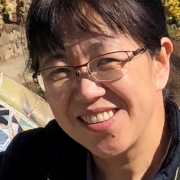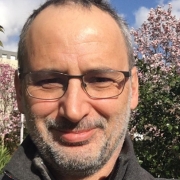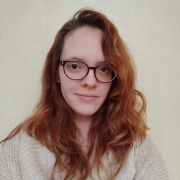Theme E: photoactive molecules and molecular assemblies for biological and biomedical applications
Photoactivable NADPH mimics targeting nitric oxide synthases
Nitric-oxide synthases (NOS) catalyze the formation of NO using NADPH as electron donor. We have designed and synthesized a new series of two-photon absorbing and photoactivatable NADPH analogues (NT), bearing one or two carboxymethyl group(s) on the 2′- or/and 3′-position(s) of the ribose in the adenosine moiety, instead of a 2′-phosphate group, and differ by the nature of the electron donor in their photoactivatable chromophore (replacing the nicotinamide moiety). These compounds display good binding affinity towards the constitutive nNOS and eNOS, confirming that the carboxymethyl group can be used as a surrogate of phosphate. We found that, two compounds, those bearing a single carboxymethyl group on the 3′-position of the ribose, colocalize with the Golgi apparatus (the main intracellular location of eNOS) and display high intracellular two-photon brightness. Furthermore, a eNOS-dependent photooxidation was observed for these two compounds only, which is accompanied by a substantial intracellular NO production accounting for specific photocytotoxic effects. Therefore, we show for the first time that NT photoactivation efficiently triggers electron flow at the eNOS level and increases the basal production of NO by endothelial cells while no detectable NT fluorescence was obtained in HeLa cells.
Fluorescent cyclodextrin
We have developed a DCM-appended β-cyclodextrin DCM7-β-CD, which, in the presence of 1 bromonaphthalene-modified functional peptides (P1-P4), undergoes an ordered self-assembly process to affords structurally unique supramolecular architectures, so-called Spds. HRTEM images and DLS analyses revealed peptide-dependent particle morphologies with diameters of ∼100 nm. The Spds prepared from probes P1-P3 demonstrated excellent cell permeability, which facilitated the intracellular delivery of the constituent probe and enabled the intracellular cellular imaging of an apoptosis biomarker (caspase-3) and mitosis events. The present self-assembly strategy was extended to include an antimicrobial peptide and was found to improve the efficacy in the case of both Gram-positive and –negative bacteria. In addition, a fluorescent Spd-4 was developed. It engendered greater bacteria cellular uptake relative to peptide alone. This proved true in both E. coli. (ATCC 25922) and S. aureus (ATCC 25923). We thus conclude that the Spd delivery strategy described here may have a role to play in overcoming the limitations of bioactive functional peptides. Ultimately, this could lead to the development of more effective peptide-based diagnostic and therapeutic agents.
Photoswitchable glycomacrocycles
We have firstly developed a one-pot O-alkylation mediated macrocyclization approach for the synthesis of carbohydrate-based macrocyclic azobenzenes. The synthesized macrocycles can be reversibly isomerized between E and Z isomers upon UV or visible irradiation with excellent photostability and thermal stability. A chirality transfer from the chiral sugar unit to azobenzene was observed by circular dichroism (CD). DFT and TD-DFT calculations were performed to calculate the optimal geometry and the theoretical absorption and CD spectra. Comparison of the experimental CD spectra with the theoretical ones suggests that both E and Z-macrocycles adopt preferentially P-helicity for the azobenzene moiety. Furthermore, one macrocycle showed gelation ability in cyclohexane and ethanol with multistimuli-responsive behavior upon exposure to environmental stimuli including thermal-, photo-, and mechanical responses. Moreover, these organogels display temperature-dependent helical inversion, which can be tuned by a repeated heating-cooling procedure.
We have successfully used these photoswitchable glycomacrocycles as chiral dopant for liquid crystals and demonstrated the dynamic control of helical superstructures in response to light stimulus of photoresponsive cholesteric liquid crystals (CLCs) doped with glycomacrocyclic azobenzene derivatives which exhibit large conformational changes. An unprecedented shortening of the helical pitch length and the empowerment of helical twisting power up to 500% are observed upon E®Z photoisomerization. Light-driven dynamic helix twisting and untwisting behavior affords the first example of glycomacrocyclic azobenzene-based CLCs, which can drive the mechanical movement of micro-objects. Two modes of rotation - two-directional or one-directional rotational motion (crankshaft mode) - are realized. In particular, the latter mode based on the reversible cholesteric texture transition between homogeneous stripes and focal conics leads to the accumulation of the rotation angles achieving the amplified mechanical movements.
Secondly, we have synthesized seven new photoswitchable glycomacrocycles through intramolecular glycosylation, which enlarges the chiral cycloazobenzene library. Excellent a-stereoselectivity can be achieved by using p- and o-dihydroxy azobenzene templates, demonstrating the proof-of-concept of using a photoswitchable template to achieve the challenging 1,2-cis glycosylation. The E®Z photoisomerization influenced mainly the efficiency of the intramolecular glycosylation. Chiroptical properties have been observed for two of the o-substituted azobenzene macrocycles with inversion of helical chirality upon E®Z photoisomerization for one of them.
Fluorescent probes for neuroscience (I. Leray, C. Mongin)
The understanding of biological phenomena in the context of synaptic transmission remains of major interest in the field of neuroscience. In collaboration with N. Rouach's group (CIRCB-UMR7241, Collège de France), we will develop new fluorescent probes to follow the behavior of neurons and astrocytes during synaptic transmission. This work was initiated in the context of the work on potassium-selective fluorescent probes. The aim is to be able to follow in real time during electrophysiology experiments the variations of extracellular potassium. In particular, the study of ion channel dysfunction is very important in the understanding of certain pathologies such as epilepsy. We are interested in the synthesis of fluorescent tracers of known neurotransmitters. We have synthesized glutamine analogues containing a rhodamine which have been incorporated into astrocytes of a mouse brain, allowing to identify by fluorescence a protein responsible for glutamine transmission. We plan to develop glutamine analogues whose fluorescence is modified when switching from the glutamine form to the glutamate form. Other compounds containing D-serine will also be synthesized.
Fluorescent molecules, polymers and nanoparticles for imaging and detection (G. Clavier)
Drug nanovectors (NVs) are expected to profoundly change therapeutic treatments in highly prevalent diseases such as rheumatoid arthritis. However, NV accumulation can be heterogeneous and a patient selection, based on imaging of NV fine localization, could improve treatment efficacy. The CAP-PHOTOAC project aims to develop clinically relevant NVs tagged with organic contrast agents for photoacoustic imaging (PAI) to elucidate intratissue distribution. PAI is an emerging imaging modality able to map (cm depth, ~0.1 mm resolution) optical absorption in vivo. Novel molecular absorbers will be developed to label the polymeric NVs. pH sensitive fluorophores will also be prepared and included in the NVs to study their cellular penetration. Labelled NVs will be characterized in terms of stability, biocompatibility, photophysical and photoacoustic properties. The kinetic of their intratissue and intracellular accumulation will be mapped in a mouse model by PAI and fluorescence imaging.
National collaborations
International collaborations
- Pr C. Ortiz Mellet (Department of Organic Chemistry, University of Sevilla, Spain)
- Dr J. M. Garcia Fernandez (Institute for Chemical Research, CSIC – University of Sevilla, Spain)
- Pr Y. Kim (Division of Material and Environmental Chemistry, Utsunomiya University, Japan)
- Pr X.-P. He, Pr. G.-R. Chen (Institute of Fine Chemicals, East China University of Science and Technology, China)
- Pr Y. Hosokawa (Division of Materials Science, Graduate School of Science and Technology, Nara Institute of Science and Technology, Japan)
- Pr D. O’Shea (Chemistry Department, Royal College of Surgeons in Ireland, Ireland)
Research contracts
Booster program (2019-2021, ENS Paris-Saclay)
ANR CAP-PhotoAc
Theme E managers

Participants






Alumni
- Dr Clément Polese (read his PhD online)
- Dr Yanyang Tian (read her PhD online)
- Dr Yang Si (read her PhD online)
- Dr Chloé Grazon (read her PhD online)



